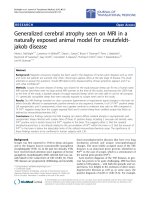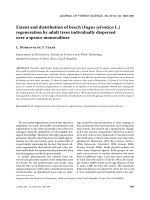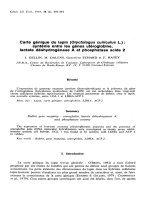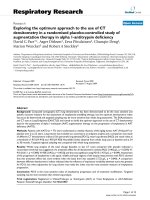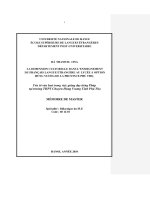Michael l grey, jagan mohan ailinani CT MRI pathology a pocket atlas, third edition mcgraw hill education medical (2018)
Bạn đang xem bản rút gọn của tài liệu. Xem và tải ngay bản đầy đủ của tài liệu tại đây (42.3 MB, 570 trang )
2
Copyright © 2018 by McGraw-Hill Education. All rights reserved. Except
as permitted under the United States Copyright Act of 1976, no part of this
publication may be reproduced or distributed in any form or by any means,
or stored in a database or retrieval system, without the prior written
permission of the publisher.
ISBN: 978-1-26-012195-7
MHID: 1-26-012195-X
The material in this eBook also appears in the print version of this title:
ISBN: 978-1-26-012194-0, MHID: 1-26-012194-1.
eBook conversion by codeMantra
Version 1.0
All trademarks are trademarks of their respective owners. Rather than put a
trademark symbol after every occurrence of a trademarked name, we use
names in an editorial fashion only, and to the benefit of the trademark
owner, with no intention of infringement of the trademark. Where such
designations appear in this book, they have been printed with initial caps.
McGraw-Hill Education eBooks are available at special quantity discounts
to use as premiums and sales promotions or for use in corporate training
programs. To contact a representative, please visit the Contact Us page at
www.mhprofessional.com.
NOTICE
Medicine is an ever-changing science. As new research and clinical
experience broaden our knowledge, changes in treatment and drug therapy
are required. The authors and the publisher of this work have checked with
sources believed to be reliable in their efforts to provide information that is
complete and generally in accord with the standards accepted at the time of
publication. However, in view of the possibility of human error or changes
in medical sciences, neither the authors nor the publisher nor any other
party who has been involved in the preparation or publication of this work
warrants that the information contained herein is in every respect accurate
or complete, and they disclaim all responsibility for any errors or
omissions or for the results obtained from use of the information contained
in this work. Readers are encouraged to confirm the information contained
herein with other sources. For example and in particular, readers are
3
advised to check the product information sheet included in the package of
each drug they plan to administer to be certain that the information
contained in this work is accurate and that changes have not been made in
the recommended dose or in the contraindications for administration. This
recommendation is of particular importance in connection with new or
infrequently used drugs.
TERMS OF USE
This is a copyrighted work and McGraw-Hill Education and its licensors
reserve all rights in and to the work. Use of this work is subject to these
terms. Except as permitted under the Copyright Act of 1976 and the right
to store and retrieve one copy of the work, you may not decompile,
disassemble, reverse engineer, reproduce, modify, create derivative works
based upon, transmit, distribute, disseminate, sell, publish or sublicense the
work or any part of it without McGraw-Hill Education’s prior consent.
You may use the work for your own noncommercial and personal use; any
other use of the work is strictly prohibited. Your right to use the work may
be terminated if you fail to comply with these terms.
THE WORK IS PROVIDED “AS IS.” McGRAW-HILL EDUCATION
AND ITS LICENSORS MAKE NO GUARANTEES OR WARRANTIES
AS TO THE ACCURACY, ADEQUACY OR COMPLETENESS OF OR
RESULTS TO BE OBTAINED FROM USING THE WORK,
INCLUDING ANY INFORMATION THAT CAN BE ACCESSED
THROUGH THE WORK VIA HYPERLINK OR OTHERWISE, AND
EXPRESSLY DISCLAIM ANY WARRANTY, EXPRESS OR IMPLIED,
INCLUDING BUT NOT LIMITED TO IMPLIED WARRANTIES OF
MERCHANTABILITY OR FITNESS FOR A PARTICULAR PURPOSE.
McGraw-Hill Education and its licensors do not warrant or guarantee that
the functions contained in the work will meet your requirements or that its
operation will be uninterrupted or error free. Neither McGraw-Hill
Education nor its licensors shall be liable to you or anyone else for any
inaccuracy, error or omission, regardless of cause, in the work or for any
damages resulting therefrom. McGraw-Hill Education has no
responsibility for the content of any information accessed through the
work. Under no circumstances shall McGraw-Hill Education and/or its
licensors be liable for any indirect, incidental, special, punitive,
consequential or similar damages that result from the use of or inability to
use the work, even if any of them has been advised of the possibility of
4
such damages. This limitation of liability shall apply to any claim or cause
whatsoever whether such claim or cause arises in contract, tort or
otherwise.
5
CONTENTS
Contributing Authors
Preface
Acknowledgments
Special Acknowledgments
Nuclear Magnetic Resonance Imaging (NMRI)
PART I
PRINCIPLES OF IMAGING IN COMPUTED
TOMOGRAPHY AND MAGNETIC RESONANCE
IMAGING
PART II
CONTRAST MEDIA
CT and MRI Contrast Agents
CT Contrast Agents
Contrast-Induced Nephropathy
Metformin (Glucophage)
MR Contrast Agents
Nephrogenic Systemic Fibrosis
Intravenous (IV) Contrast and the Pregnant Patient
PART III
CENTRAL NERVOUS SYSTEM
Brain
Neoplasm
Acoustic Neuroma
Astrocytoma
6
Brain Metastasis
Craniopharyngioma
Ependymoma
Glioblastoma Multiforme
Lipoma
Medulloblastoma
Meningioma
Oligodendroglioma
Pituitary Adenoma
Brain
Congenital
Agenesis of the Corpus Callosum
Arachnoid Cyst
Crainosynostosis
Dandy-Walker Syndrome
Encephalocele
Hydrocephalus
Neurofibromatosis (NF1)
Tuberous Sclerosis
Brain
Phakomatosis
Sturge-Weber Syndrome
Von Hippel-Lindau Disease
Brain
Vascular Disease
Arteriovenous Malformation
Intracranial Aneurysm
Intracerebral Hemorrhage (Hemorrhagic Stroke)
Ischemic Stroke (Cerebrovascular Accident)
Neurovascular Compression Syndrome (NVCS)
Superior Sagittal Sinus Thrombosis
7
Brain
Degenerative Disease
Alzheimer’s Disease
Multi-Infarct Dementia
Normal-Pressure Hydrocephalus
Parkinson’s Disease
Brain
Demyelinating
Multiple Sclerosis
Brain
Infection
Brain Abscess
Cysticercosis
Brain
Trauma
Brain Herniation
Diffuse Axonal Injury
Epidural Hematoma
Subarachnoid Hemorrhage
Subdural Hematoma
Spine
Congenital
Arnold-Chiari Malformation
Syringomyelia/Hydromyelia
Tethered Cord
Spine
Degenerative
Herniated Disk
Spinal Stenosis
Spondylolisthesis
8
Spine
Demyelinating
Multiple Sclerosis (Spinal Cord)
Spine
Infection
Vertebral Osteomyelitis
Spine
Tumor
Metastatic Disease to the Spine
Spinal Ependymoma
Spinal Hemangioma
Spinal Meningioma
Spine
Trauma
Burst Fracture
C1 Fracture
Cervical Facet Lock
Vertebral Compression Fracture
Spinal Cord Hematoma
Fracture/Dislocation (C6-C7)
Odontoid Fracture
Spine
Vascular Disease
Spinal Cord Ischemia/Infarction
PART IV
HEAD AND NECK
Congenital
Brachial Cleft Cyst
Tumor
9
Cavernous Hemangioma (Orbital)
Cholesteatoma (Acquired)
Glomus Tumor (Paraganglioma)
Parotid Gland Tumor (Benign Adenoma)
Thyroid Goiter
Infection
Peritonsillar Abscess
Submandibular Salivary Gland Abscess
Sinus
Mucocele
Sinusitis
Trauma
Intraocular Foreign Body
Tripod Fracture
PART V
CHEST AND MEDIASTINUM
Cardiac
Aberrant Right Subclavian Artery
Aortic Regurgitation
Atrial Myxoma
Coronary Artery Disease
Pericardial Effusion
Situs Inversus
Superior Vena Cava Syndrome
Infection
Histoplasmosis
Lungs
Adult Respiratory Distress Syndrome
Asbestosis
Bronchogenic Carcinoma
10
Bullous Emphysema
Mesothelioma
Pleural Effusion
Pulmonary Emboli
Pulmonary Fibrosis
Pulmonary Metastatic Disease
Sarcoidosis
Mediastinum
Hodgkin Disease
Thymoma
Aorta
Aortic Coarctation
Aortic Dissection
Breast
Breast Cancer
Breast Implant Leakage
Trauma
Aortic Tear
Diaphragmatic Hernia
Lung Contusion
Pneumothorax
PART VI
ABDOMEN
Gastrointestinal
Carcinoid
Colorectal Cancer
Crohn’s Disease
Free Intraperitoneal Air
Gastric Carcinoma
Intussusception
11
Ischemic Bowel
Large Bowel Obstruction
Mesenteric Adenitis
Mesenteric Ischemia
Small Bowel Obstruction
Volvulus
Hepatobiliary
Cavernous Hemangioma
Choledochal Cysts
Choledocholithiasis
Fatty Infiltration of the Liver
Focal Nodular Hyperplasia
Hemochromatosis
Hepatic Adenoma
Hepatic Cysts
Hepatic Metastases
Hepatoma
Pancreas
Pancreatic Adenocarcinoma
Pancreatic Pseudocyst
Pancreatitis
Genitourinary
Agenesis of the Kidney
Angiomyolipoma
Horseshoe Kidney
Perinephric Hematoma
Polycystic Kidney Disease
Pyelonephritis
Renal Artery Stenosis
Renal Calculus
Renal Cell Carcinoma
12
Renal Infarct
Wilms’ Tumor
Infection
Appendicitis
Diverticulitis
Perinephric Abscess
Renal Abscess
Trauma
Liver Laceration
Renal Laceration
Splenic Laceration
Miscellaneous
Adrenal Adenoma
Adrenal Metastases
Aortic Aneurysm (Stent-Graft)
Hernia: Hiatal Hernia
Hernia: Inguinal Hernia
Hernia: Spigelian Hernia
Hernia: Ventral Hernia
Lymphoma
Soft-Tissue Sarcoma
Splenomegaly
PART VII
PELVIS
Adenomyosis
Benign Prostatic Hyperplasia
Bladder Cancer
Cervical Cancer
Ovarian Carcinoma
Ovarian Cyst
13
Prostate Carcinoma
Rectal Cancer
Uterine Leiomyoma (Fibroid Uterus)
PART VIII
MUSCULOSKELETAL
Shoulder
Hill-Sachs Fracture (Defect)
Labral Tear
Pectoralis Major Tendon Tear
Rotator Cuff Tear
Elbow
Biceps Brachii Tendon Tear
Triceps Tendon Tear
Hand and Wrist
Carpal Tunnel Syndrome
Gamekeeper Thumb
Ganglion Cyst
Kienbock Disease
Triangular Fibrocartilage Tear
Hip
Avascular Necrosis (Osteonecrosis)
Femoral Neck Fracture
Hip Dislocation
Knee
Anterior Cruciate Ligament Tear
Baker Cyst
Bone Contusion (Bruise)
Lateral Collateral Ligament Tear
Meniscal Tear
Osteoarthritis
14
Osteosarcoma
Patellar Fracture
Posterior Cruciate Ligament Tear
Quadriceps Tear
Radiographic Occult Fracture
Tibial Plateau Fracture
Unicameral (Simple) Bone Cyst
Ankle and Feet
Achilles Tendon Tear
Brodie Abscess
Diabetic Foot
Peroneal Tendon Tear
Sinus Tarsi Syndrome
Vascular
Peripheral Arterial Disease
Miscellaneous
Ewing Sarcoma
Index
15
CONTRIBUTING AUTHORS
Michael Erik Landman, MD
Department of Radiology
Vanderbilt University Medical Center
Neal Weston Langdon, MD
Department of Radiology
Vanderbilt University Medical Center
Kim L. Sandler, MD
Department of Radiology
Vanderbilt University Medical Center
16
PREFACE
In this third edition of the CT and MRI Pathology: A Pocket Atlas, several
new additions have been included. Probably the first noticeable new
addition is the section titled CT and MRI Contrast Agents. This section
contains an overview of the pertinent issues concerning contrast agents
used in CT and MRI. New cases in cardiac, spine, a series of hernia cases,
and additional musculoskeletal cases have been added throughout the book
to increase the breadth of this new edition.
17
ACKNOWLEDGMENTS
I would like to express my gratitude to my wife Rebecca and my children
Kayla, Emily, and Megan for allowing me time away from home to
complete this new edition. Many thanks to all the wonderful people around
the United States and throughout the world who have benefited from this
book and their kind compliments.
It has been 30 years since my initial diagnosis of cancer. I would like to
thank my Lord and Savior Jesus Christ for His loving grace and mercy,
and the many miracles I have seen and experienced along life’s journey.
Thank you,
Michael
First, I am grateful to all of you who made the first edition of the CT &
MRI Pathology: A Pocket Atlas so popular in 2003 that it led to the second
edition in 2012 and now to the third edition. I would like to thank Michael
Grey for all his support and help. Finally, I would like to thank my
wonderful wife Uma for always being there for me.
Thank you,
Jagan
18
SPECIAL ACKNOWLEDGMENTS
From the initial publication of the first edition of CT & MRI Pathology: A
Pocket Atlas textbook in 2003 to this current third edition many
individuals have given me invaluable support and encouragement and
helped to see this book through. To them I have thanked and given credit
in previous editions.
Along life’s journey, others have come and influenced my life in
special ways, and I would like to take this opportunity to express my deep
appreciation to them. Without these people, I know that I would not be
where I am today.
Charles Coffey II
Jackie Darling
Ho See Kim
Steve and Cathy Jensen
Paul Mills
Marilyn Paulk
Paul Sarvela
I am forever grateful to God for these friends and how they have touched
my life.
Thank you all!
Michael L. Grey
19
NUCLEAR MAGNETIC
RESONANCE IMAGING (NMRI)
This is a photo of the first commercially made Nuclear Magnetic
Resonance (NMR) Imaging unit in the world. NMR Imaging is commonly
referred to today as Magnetic Resonance Imaging (MRI).
This photo shows the Head coil (H), the Body coil (B) in the center of
the bore, and the plastic housing (P). This NMR unit was a Technicare
0.15T Resistive system. As a show site to the world, visitors were
frequent, and many tours were given to introduce this new technology to
the world.
This photo was taken in the mid-1980s. By that time, several companies
had also begun producing their own NMR units. The gentlemen posing for
this photo are Michael Grey (standing) and the service engineer
(positioned on the patient couch).
20
PART
I
Principles of Imaging in Computed
Tomography and Magnetic
Resonance Imaging
21
PRINCIPLES OF IMAGING IN
COMPUTED TOMOGRAPHY AND
MAGNETIC RESONANCE
IMAGING
Since the initial discovery of x-ray by Wilhelm Conrad Roentgen on
November 8, 1895, the field of radiology has experienced two major
breakthroughs that have revolutionized how we look into the patient’s
body. The first, computed tomography (CT) came in the early 1970s. The
second, magnetic resonance imaging (MRI) was initially introduced in the
early 1980s.
In CT, a finely collimated x-ray beam is directed upon the patient. As
the x-ray tube travels around the patient, x-rays are emitted toward the
patient. As these x-rays interact with the various tissues in the patient’s
body, some of the x-rays are attenuated by the tissues while others are
transmitted through the tissues and interact with a very sensitive electronic
detector. The purpose of these detectors is to measure the amount of
radiation that has been transmitted through the patient. After the amount of
radiation has been measured, the detector converts the amount of radiation
received into an electronic signal that is sent to a computer. The computer
then performs mathematical calculations on the information received and
reconstructs the desired image. This information is assigned a numerical
value that represents the average density of the tissue in that respective
pixel/voxel of tissue. These numerical values reflect the patient’s tissue
attenuation characteristics and may be referred to as Hounsfield numbers,
Hounsfield units (HU), or CT numbers that range from approximately
−1000 (air) to +3000 (dense bone or tooth enamel). CT uses water as its
standard value and it is assigned a Hounsfield number of 0.
To diagnose a disease process, the radiologist looks for changes in the
normal density (HU) of an organ, an abnormal mass, or an altered or loss
of normal anatomy. The advantages of CT include its ability to image
patients that (1) have experienced trauma, (2) are suspect to have had a
stroke, (3) are acutely ill, (4) have a contraindication to MRI, or (5) require
22
better bone detail that can be scanned in CT in a quick and efficient
manner. In addition, since the development of helical (spiral) CT in the
early 1990s with single-slice technology and further technological
advances in the mid-1990s to multi-slice imaging, CT is able to perform
volumetric imaging quickly and generate reformatted anatomic images in
any plane (e.g., sagittal or coronal). The disadvantages of CT include (1)
exposure to the radiation dosage, (2) possible reaction to the iodinated
contrast agent, (3) lack of direct multiplanar imaging, and (4) loss of softtissue contrast when compared to MRI.
MRI incorporates the use of a strong magnetic field and smaller
gradient magnetic fields in conjunction with a radiofrequency (RF) signal
and RF coils specifically tuned to the Larmor frequency of the proton
being imaged. An image is acquired in MRI by placing the patient into a
strong magnetic field and applying an RF signal at the Larmor frequency
of the hydrogen proton (42.58 MHz/T). Gradient magnetic fields are used
to assist with spatial localization of the RF signal. The gradients are
assigned to the tasks of slice selection, phase encoding, and frequency
encoding or readout gradient. In the magnet, the patient’s hydrogen
protons align either parallel (with) or antiparallel (against) the magnetic
field. The RF signal is rapidly turned on and off. When the RF signal is
turned on, the protons are flipped away from the parallel axis of the
magnetic field. Once the RF is turned off, the protons begin to relax back
into the parallel orientation of the magnetic field. During the relaxation
time, a signal from the patient is being received by the coils and sent to the
computer for image reconstruction. This process is repeated several times
until the image is acquired.
There are several different types of pulse sequences used in MRI to
acquire patient information. These can be grouped into proton (spin)
density, and T1-weighted and T2-weighted pulse sequences. These pulse
sequences demonstrate the anatomy differently and help differentiate
between normal and abnormal structures. A combination of these pulse
sequences may be used to assist with the diagnosis.
A T1-weighted pulse sequence uses a short TR (repetition time) and
short TE (echo time) values to produce a high or bright signal in
substances such as fat, acute hemorrhage, and slow-flowing blood.
Structures such as cerebrospinal fluid and simple cysts may appear with a
low or dark signal. In many cases, the pathologic process will appear with
low signal in T1-weighted images.
A proton-density-weighted image uses long TR and short TE values to
produce images based on the concentration of hydrogen protons in the
23
tissue. The brighter the area, the greater the concentration of hydrogen
protons. The darker the area, the fewer the number of hydrogen protons.
A T2-weighted pulse sequence uses long TR and long TE values to
obtain a high signal in substances such as cerebrospinal fluid, simple cysts,
edema, and tumors. Structures such as fat and muscle will appear with low
signal. Many pathologic conditions present with high signal on T2weighted pulse sequences.
MRI has several advantages such as (1) it acquires patient information
without the use of ionizing radiation; (2) it produces excellent soft tissue
contrast; (3) it can acquire images in the transverse (axial), sagittal,
coronal, or oblique (orthogonal) planes; and (4) image quality is not
affected by bone. The disadvantages primarily associated with MRI would
include: (1) any contraindication that would present a detrimental effect to
the patient or health care personnel; (2) long scan time when compared to
CT; and (3) cost. The effects of the magnetic field, varying gradient
magnetic fields, or the RF energy used pose the greatest harmful effects to
biomedical implants that may be in the patient’s body. Before entrance
into the strong magnetic field can be obtained, everyone including patients,
family members, health care professionals, and maintenance workers must
be screened for any contraindications that may result in injury to
themselves or others. These may include any biomedical implant or device
that is electrically, magnetically, or mechanically activated such as
pacemakers, cochlear implants, and certain types of intracranial aneurysm
clips and orbital metallic foreign bodies. The contraindications focus on
devices that may move or undergo a torque-effect in the magnetic field,
overheat, produce an artifact on the image, or become damaged or
functionally altered. Most magnets used in MRI are superconductive and
the magnetic field is always on. Any ferromagnetic material (e.g., O2 tank,
wheelchairs, stretchers, scissors) may become a projectile and potentially
cause an injury or death when brought into the magnetic environment.
24
PART
II
Contrast Media
25


